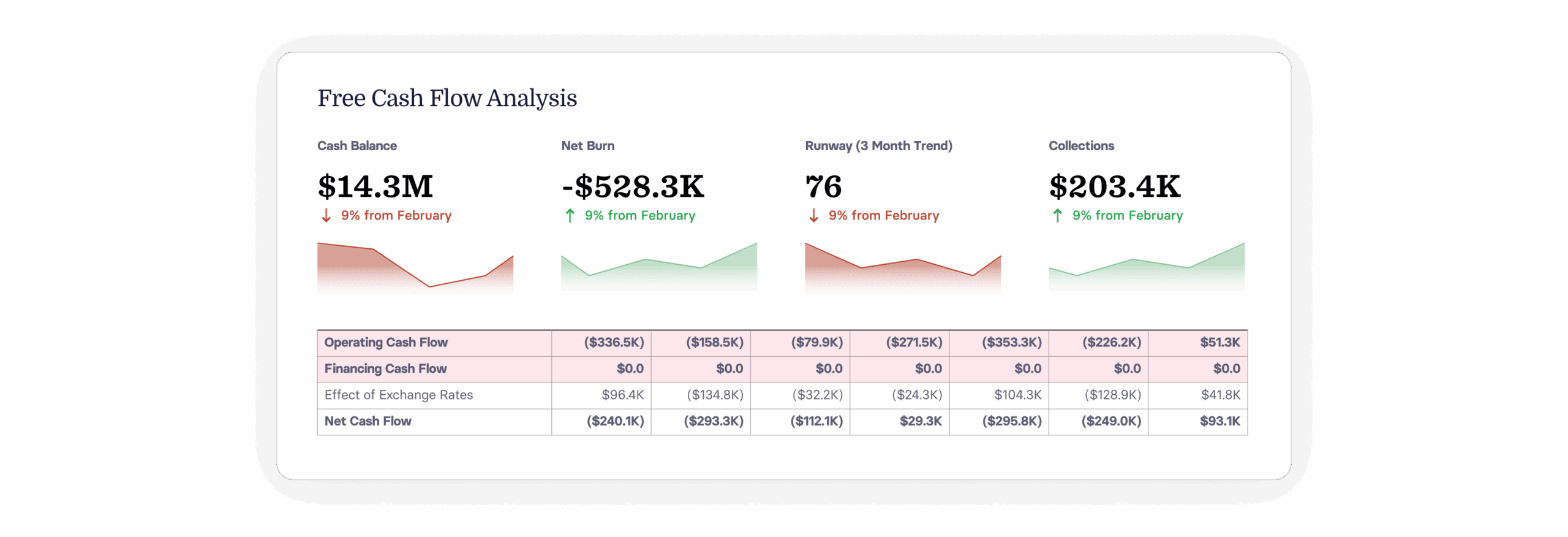Free cash flow (FCF) represents the cash a company generates after accounting for operating expenses and capital expenditures, providing a clear view of financial health.
What is free cash flow?
Free cash flow is the cash a company has left over after covering all its expenses. Free cash flow includes operating costs like payroll, equipment, rent, and insurance, as well as the cost of maintaining current assets and meeting other financial obligations.
<<Download the SaaS metrics cheat sheet today!>>

For publicly traded companies, free cash flow represents the funds left after covering operational costs—money that can be used to pay down debt, distribute dividends, or pursue acquisitions. As a company grows and moves closer to an IPO, free cash flow becomes a key indicator for investors and lenders, offering a clearer picture of the company’s value and its ability to generate returns.
Free cash flow is typically reported annually in 10-K filings, but many companies also share it quarterly in 10-Qs. Internally, especially if you’re preparing for an IPO or already operating as a public company, it’s critical to maintain real-time visibility into free cash flow and other core financial metrics.
How is free cash flow calculated?
Free cash flow is a key financial metric used to evaluate a company’s performance. There are a few ways to calculate it, and while each method may vary slightly, they should all yield roughly the same result.
The simplest approach is to start with your operating cash flow from the cash flow statement and subtract capital expenditures (CapEx).

You could also use a variety of net income statements and balance sheet line items to get to your free cash flow number. Here are a couple of different methods:
- Subtract your net investment in operating capital from your net operating profit after taxes to find your free cash flow
- The formula would be: (Net Operating Profit – Taxes) – Net Investment in Operating Capital = Free Cash Flow
- Subtract your required investments in operating capital from your sales revenue, less your operating costs, including taxes, to find your free cash flow
- The formula would be: Sales Revenue – (Operating Costs + Taxes) – Required Investments in Operating Capital = Free Cash Flow
Why free cash flow matters—and how to interpret it
There are two key perspectives on why free cash flow (FCF) is important: internal and investor-facing.
Internally, FCF helps finance teams and leadership understand how much flexibility the business has to reinvest. Do you have enough available cash to develop new products, expand into new markets, or acquire another company? Can you support buybacks or dividends to keep shareholders engaged? These types of decisions hinge on having clear visibility into your free cash flow.
From the investor’s perspective, FCF offers a snapshot of your company’s financial health. It’s often used as a starting point to evaluate profitability and assess how well your business generates value.
Ultimately, investors want to see that free cash flow is being put to work—fueling growth, innovation, or returns. That doesn’t mean FCF must always be positive, but it does mean you need to show how profits are being strategically invested to move the business forward.
<<Build the right narrative with the playbook for board and investor communications.>>
What is free cash flow margin?
While we’ve covered what free cash flow is and how to calculate it, it’s also worth understanding free cash flow margin. This metric shows how much of a company’s revenue is converted into free cash flow—and it’s a useful indicator of how efficiently a business manages both its operating expenses and capital investments.
Calculating and interpreting free cash flow margin
To calculate free cash flow margin, divide your free cash flow by total revenue, then multiply by 100. The result shows the percentage of each dollar of revenue that remains as free cash flow—offering a clear view of your company’s financial efficiency.

A higher free cash flow margin suggests that the company is effectively controlling its costs and is efficient in its operations. It’s a sign of a healthy, well-run business with the potential for growth and profitability.
Why free cash flow margin matters
In financial analysis and investor evaluation, free cash flow margin offers a more nuanced view than free cash flow alone. It shows not just how much cash your business generates, but how efficiently that cash is produced in relation to revenue. This level of insight is especially important in industries where controlling operational and capital costs is critical to long-term profitability.
What’s considered “good” free cash flow?
While free cash flow can reveal a lot about a company’s financial health, what qualifies as “good” depends on your industry. For SaaS businesses, a healthy level of free cash flow means having enough on hand to cover at least a month’s worth of operating costs—and ideally, more.
Some investors and analysts believe that a good free cash flow for a SaaS company is anywhere from about 20 percent to 25 percent. But as always, context matters—what’s “good” should align with your growth stage, financial strategy, and long-term goals.
We often refer to the SaaS Rule of 40 as a quick way to assess the balance between growth and profitability. It’s especially useful for companies on the path to an IPO—and continues to provide value beyond that milestone.
But you should also consider evaluating “good” free cash flow in terms of Bessemer’s efficiency score — the sum of your growth percentage and free cash flow margin percentage. Like the rule of 40, anything above 40 in this calculation is considered “good” and bodes well for the valuation of your SaaS company.
Challenges in tracking free cash flow
One of the biggest challenges in tracking free cash flow is adding the right context to tell your company’s financial story clearly and accurately.
Unlike other financial metrics, free cash flow doesn’t come with standard disclosure requirements, making it less visible on formal reports. If you don’t break it out proactively, investors and analysts may calculate it themselves—and potentially miss key context.
That can lead to confusion. For instance, a year-over-year drop in free cash flow might look concerning at first glance, but it could reflect a strategic investment—like acquiring a company to expand your total addressable market.
Manual reporting adds to the challenge, pulling time and focus away from the bigger picture. Automating calculations and streamlining data collection frees up time to focus on what really matters: crafting a clear narrative about the financial health and growth of your business.
<<Streamline your financial reporting process with this comprehensive checklist.>>
Key takeaways
- Free cash flow (FCF) represents the cash a company generates after accounting for operating expenses and capital expenditures, providing a clear view of financial health
- It is a crucial metric for assessing a company’s ability to reinvest in the business, pay down debt, or return value to shareholders through dividends
- Calculating FCF involves subtracting capital expenditures from operating cash flow, offering multiple methods for precise analysis
- A positive FCF signals potential for growth and financial stability, while FCF margin helps evaluate revenue conversion efficiency into cash flow
- Understanding FCF is vital for internal strategic decisions and is a key indicator for investors assessing a company’s profitability and value
Get a clearer view of your company’s health with smarter free cash flow tracking
When you have real-time visibility into your company’s free cash flow, you’re better equipped to make informed decisions—and understand how investors may view your financial position.
Modern financial tools can simplify the process of calculating and tracking key metrics like free cash flow by automating data collection and reducing the risk of manual errors. By integrating information from your existing systems, these tools save time and let your finance team focus on the bigger picture: analyzing trends, modeling scenarios, and driving growth.
If you’re looking to move beyond spreadsheets and manual workflows, now’s the time to explore solutions that offer a more complete, real-time view of your company’s financial health.
Free cash flow FAQs
Why is free cash flow important for valuation?
Free cash flow plays an essential role in valuation as it shows how much capital a company has available to invest in growth, pay off its debts, or return dividends to investors, which is an indicator of financial health that investors use to determine its present value.
Recommended For Further Reading
What are the differences between free cash flow and EBITDA?
EBITDA is a measure of a company’s operating performance and profitability, excluding taxes, depreciation, and amortization. It’s often used to compare performance across businesses, as it strips out certain non-operating expenses.
Free cash flow (FCF), on the other hand, shows the actual cash generated from operations—what’s left after covering capital expenditures. This is the cash available for reinvestment, debt repayment, or dividends. While EBITDA highlights operating efficiency, FCF offers a clearer view of a company’s ability to generate and manage cash in real terms.
How does working capital affect free cash flow?
Working capital measures a company’s short-term financial health by comparing assets and cash inflows—like accounts receivable—against liabilities and outflows, such as accounts payable. It reflects the company’s ability to meet short-term obligations.
When calculating free cash flow, changes in working capital are key. Shifts in accounts receivable or payable can reduce free cash flow, since more cash may be tied up in daily operations. Understanding these changes helps give a clearer picture of how much cash is actually available for reinvestment or other strategic decisions.
